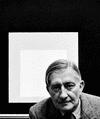- Albers, Josef
-
died March 25, 1976, New Haven, Conn., U.S.German-U.S. painter, poet, teacher, and theoretician.He studied and taught at the Bauhaus and in 1933 became one of the first Bauhaus teachers to immigrate to the U.S., where he taught at Black Mountain College and later at Yale. He developed a painting style characterized by abstract rectilinear patterns and primary colours as well as black and white. His best-known series of paintings, Homage to the Square (begun in 1950 and continued until his death), restricts its repertory of forms to coloured squares superimposed onto each other. The arrangement of these squares is carefully calculated so that the colour of each square optically alters the sizes, hues, and spatial relationships of the others. His research into colour theory was published in the influential Interaction of Color (1963).
 Josef Albers, photograph by Arnold Newman, 1948.© Arnold Newman
Josef Albers, photograph by Arnold Newman, 1948.© Arnold Newman* * *
▪ American painterborn March 19, 1888, Bottrop, Ger.died March 25, 1976, New Haven, Conn., U.S.painter, poet, sculptor, teacher, and theoretician of art, important as an innovator of such styles as Colour Field painting and Op art.From 1908 to 1920 Albers studied painting and printmaking in Berlin, Essen, and Munich and taught elementary school in his native town of Bottrop. In 1920 he enrolled at the newly formed Bauhaus, which was to become the most important design school in Germany. His most important creations of that period included compositions made of coloured glass, as well as examples of furniture design, metalwork, and typography. After 1925, when he became a “master” at the Bauhaus, Albers explored a style of painting characterized by the reiteration of abstract rectilinear patterns and the use of primary colours along with white and black.In 1933, when the Nazi government closed the Bauhaus, Albers left Germany for the United States. On the recommendation of architect Philip Johnson (Johnson, Philip C.), Albers organized the fine-arts curriculum at Black Mountain College in North Carolina, where he taught until 1949. The next year he began a 10-year tenure as chairman of the art department of Yale University. Over the course of his time at these two schools, he counted among his students Eva Hesse, Robert Rauschenberg (Rauschenberg, Robert), and Kenneth Noland (Noland, Kenneth).After moving to the United States, Albers concentrated on several series of works that systematically explored the effects of perception. In his series of engravings on plastic Transformations of a Scheme (1948–52) and in the series of drawings Structural Constellations (1953–58), he created complex linear designs, each subject to many possible spatial interpretations. His best-known series of paintings, Homage to the Square (begun in 1950 and continued until his death), restricts its repertory of forms to coloured squares superimposed onto each other. The arrangement of these squares is carefully calculated so that the colour of each square optically alters the sizes, hues, and spatial relationships of the others. These works were exhibited worldwide and formed the basis of the first solo exhibition given to a living artist at the Metropolitan Museum of Art, New York City, in 1971.Additional ReadingNeal David Benezra, The Murals and Sculpture of Josef Albers (1985); Nicholas Fox Weber, The Drawings of Josef Albers (1984); Nicholas Fox Weber et al., Josef Albers: A Retrospective (1988).* * *
Universalium. 2010.
